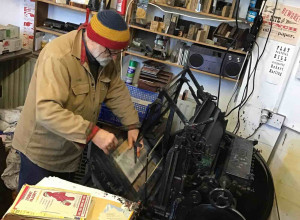Russian Propaganda Investigated in The Wolfsonian’s Summer 2018 Season
 Miami Beach, FL — For summer 2018, The Wolfsonian-Florida International University is tapping into today’s fascination with Russian propaganda through two coinciding shows focused on early 20th-century Soviet graphic design. Constructing Revolution: Soviet Propaganda Posters from Between the World Wars (April 13-August 12), organized by the Bowdoin College Museum of Art in Brunswick, Maine, and the complementary library installation Red and Black: Revolution in Soviet Propaganda Graphics (April 5-August 5) will shed light on ties between cultural life and revolutionary ideology in the decades following the 1917 Russian Revolution. Both shows explore how designers were inspired by the utopian ideals of the revolution to develop new techniques of graphic persuasion on behalf of Russia’s Communist dictatorship.
Miami Beach, FL — For summer 2018, The Wolfsonian-Florida International University is tapping into today’s fascination with Russian propaganda through two coinciding shows focused on early 20th-century Soviet graphic design. Constructing Revolution: Soviet Propaganda Posters from Between the World Wars (April 13-August 12), organized by the Bowdoin College Museum of Art in Brunswick, Maine, and the complementary library installation Red and Black: Revolution in Soviet Propaganda Graphics (April 5-August 5) will shed light on ties between cultural life and revolutionary ideology in the decades following the 1917 Russian Revolution. Both shows explore how designers were inspired by the utopian ideals of the revolution to develop new techniques of graphic persuasion on behalf of Russia’s Communist dictatorship.
“With Constructing Revolution, the stars truly aligned,” said Tim Rodgers, Wolfsonian director. “We recognized in Bowdoin’s exhibition a rare opportunity to do what The Wolfsonian does best—present some of the finest examples of modern propaganda, reexamine objects from our own collection, and offer fresh insight into a topic currently front and center on the worldwide stage.”
Bringing more than 50 Soviet-era posters from the private collection of Svetlana and Eric Silverman together with rarely seen works held by The Wolfsonian, Constructing Revolution showcases a number of key figures in the Soviet artistic avant-garde, among them Vladimir Mayakovsky, Aleksandr Rodchenko, and Gustav Klutsis. The exhibition charts the formative decades of the USSR and provides a glimpse into this turbulent period of Russian history, when posters were employed to provide a new visual language converting Communist aspirations into readily accessible, urgent, public art. The resulting images reflect a remarkable degree of artistic experimentation, even as their content was strictly guided by the priorities of the Soviet state.
Highlights include:
- Dmitrii Moor’s Death to World Imperialism (1919), which depicts a monstrous green dragon representing the dangers faced by the young Soviet state during the Civil War that broke out immediately following the 1917 Russian Revolution;
- A 1920 poster of a worker holding a banner for the May Day celebration, a design first produced in stencil for dissemination to local artists;
- Grigorii Shegal’s Down with Kitchen Slavery (1929), illustrating the Soviet state’s promise to liberate women from domestic tasks so that they could participate as workers and citizens on an equal basis to men;
- Working Men and Women-Everyone to the Election of Soviets (1930) by Gustav Klutsis, pioneer of the photomontage technique, which combines photographic images, text, and graphic elements into a single cohesive message; and
- A 1930 photomontage poster by Valentina Kulagina commemorating women’s industrial labor for International Working Women’s Day.
“These works speak to the paradox of the Soviet Union during its early decades, when utopianism went hand-in-hand with manipulation,” said Jon Mogul, Wolfsonian associate director of curatorial & education. “There is an undeniable sense of excitement, optimism, and experimentation in these images, though they also convey the sanitized and one-sided version of reality that contributed to the consolidation of a brutally repressive dictatorship.”
In conjunction with the exhibition, the focused installation Red and Black will feature roughly 20 rare books, periodicals, postcards, and portfolio plates from The Wolfsonian-FIU Library that reveal the contribution of Constructivism to Soviet graphic design. A key movement in the early 20th century, Constructivism applied abstraction and the machine aesthetic to the practical design of everything from architecture to household objects—all in service of the Communist vision of building a new, classless society.
The Wolfsonian has been recognized internationally for the attention it has given to political propaganda, a subject prevalent in both its mission and its collection of modern-age material, 1850-1950. Throughout the museum’s 22-year history, dozens of exhibitions and countless programs have investigated how objects and images were shaped into tools of political persuasion in countries across the globe.
Constructing Revolution: Soviet Propaganda Posters from Between the World Wars (Apr 13-Aug 12, 2018), organized by the Bowdoin College Museum of Art, reveals how the Soviet state wielded graphic design to inspire and manipulate the public
Red and Black: Revolution in Soviet Propaganda Graphics (Apr 5-Aug 5, 2018), examines avant-garde art in books, periodicals, postcards, and portfolio plates from The Wolfsonian-FIU Library
















